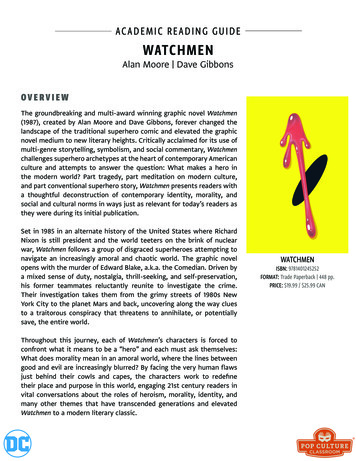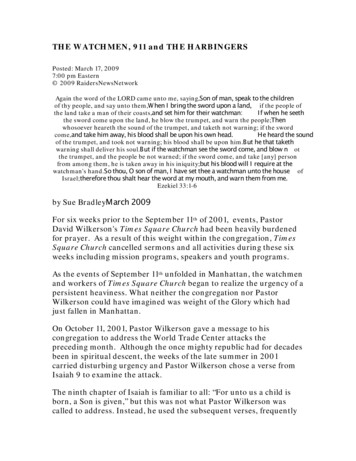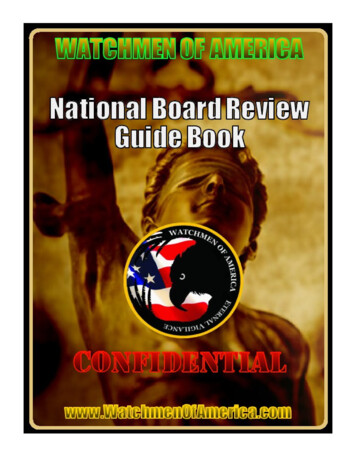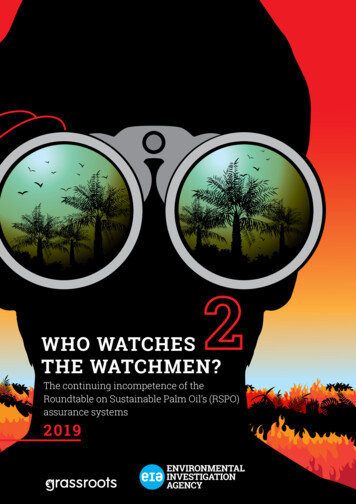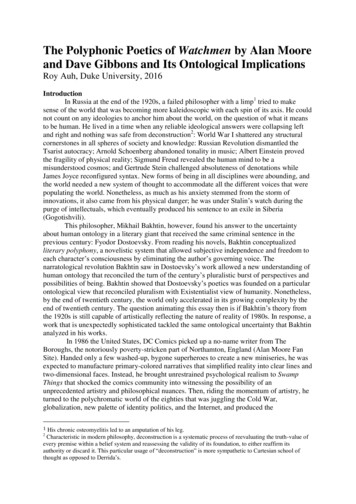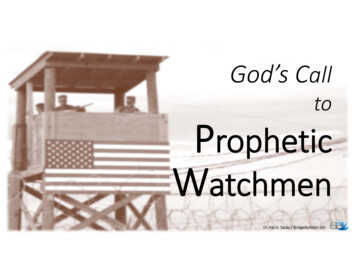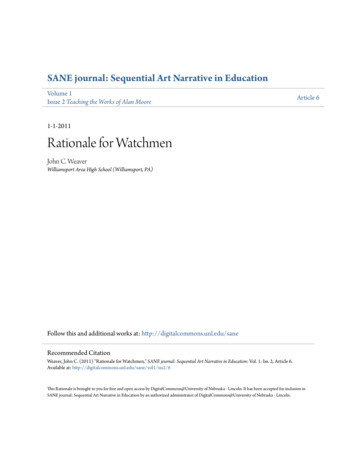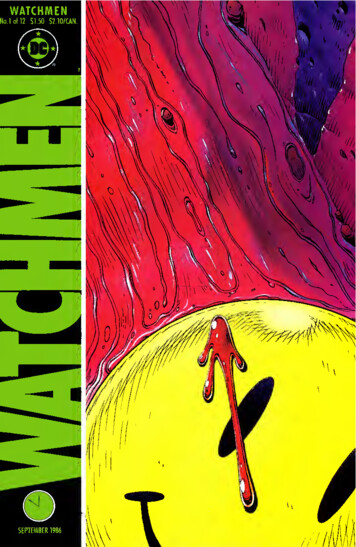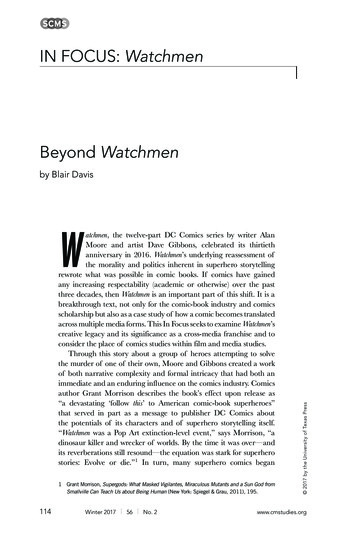
Transcription
IN FOCUS: WatchmenBeyond Watchmenby Blair Davis1 Grant Morrison, Supergods: What Masked Vigilantes, Miraculous Mutants and a Sun God fromSmallville Can Teach Us about Being Human (New York: Spiegel & Grau, 2011), 195.114Winter 2017 56 No. 2 2017 by the University of Texas PressWatchmen, the twelve-part DC Comics series by writer AlanMoore and artist Dave Gibbons, celebrated its thirtiethanniversary in 2016. Watchmen’s underlying reassessment ofthe morality and politics inherent in superhero storytellingrewrote what was possible in comic books. If comics have gainedany increasing respectability (academic or otherwise) over the pastthree decades, then Watchmen is an important part of this shift. It is abreakthrough text, not only for the comic-book industry and comicsscholarship but also as a case study of how a comic becomes translatedacross multiple media forms. This In Focus seeks to examine Watchmen’screative legacy and its significance as a cross-media franchise and toconsider the place of comics studies within film and media studies.Through this story about a group of heroes attempting to solvethe murder of one of their own, Moore and Gibbons created a workof both narrative complexity and formal intricacy that had both animmediate and an enduring influence on the comics industry. Comicsauthor Grant Morrison describes the book’s effect upon release as“a devastating ‘follow this’ to American comic-book superheroes”that served in part as a message to publisher DC Comics aboutthe potentials of its characters and of superhero storytelling itself.“Watchmen was a Pop Art extinction-level event,” says Morrison, “adinosaur killer and wrecker of worlds. By the time it was over—andits reverberations still resound—the equation was stark for superherostories: Evolve or die.”1 In turn, many superhero comics beganwww.cmstudies.org
Cinema Journal 56 No. 2 Winter 2017challenging the genre’s conventions regarding ideology, sexuality, and the very idea ofheroism itself.From the first panel’s image of an iconic smiley-face button resting against theblood-soaked gutter, Moore and Gibbons challenged the traditional formal andnarrative qualities of superhero comics (Figure 1). The story begins with a journalentry from the antihero Rorschach, one of the book’s main characters: “Dog carcass inalley this morning, tire tread on burst stomach. This city is afraid of me. I have seen itstrue face.”2 The bleak nature of these words complements (yet is not directly related to)the grim images of a shopkeeper hosing blood off the sidewalk while an unconcernedpedestrian treads through, bloody footprints trailing behind. Each panel lifts us higherand higher until we reach the broken window above, creating the semblance of a risingcrane shot that would have been almost impossible to film before digital cinema. Thefinal panel reveals a detective investigating the murder, which soon leads to the first ofthe book’s many nonlinear moments. From Gibbons’s innovative compositions to thecomplexity of Moore’s storytelling, Watchmen thoroughly challenged how comic booksrepresented their heroes.The book’s enduring popularity and critical acclaim led to its canonical statusamong comics fans and scholars, as well as some literary critics. Time chose the bookfor its list of “100 Best Novels,” alongside Animal Farm, The Big Sleep, Catcher in theRye, The Great Gatsby, Lolita, On the Road, and To Kill a Mockingbird. There has been agrowing amount of Watchmen scholarship, most notably Andrew Hoberek’s Considering“Watchmen”: Poetics, Property, Politics and Sara J. Van Ness’s “Watchmen” as Literature: ACritical Study of the Graphic Novel.3 Numerous extensions and adaptations emerged acrossa wide range of media, from live-action cinema and animation to video games andnew forms like motion comics. Many of these subsequent texts have been derided,however, by fans who see Watchmen’s legacy as becoming tainted by a series of inferiorvariations.4Sequels, prequels, and adaptations can complicate how we interpret an originaltext in light of the new works, but the notion of Watchmen and authorship is especiallycomplicated. Moore infamously walked away from any future involvement with thebook, severing ties with cocreator Gibbons in the process. He declared in 2008 ofthe following year’s feature film adaptation, “I will be spitting venom all over it.”5 IfWatchmen is a canonical text, how are auteurist readings of the franchise complicatedby these dynamics in the wake of Moore’s stance (as with DC’s 2012 series of Before2 Alan Moore and Dave Gibbons, Watchmen, no. 1 (New York: DC Comics, 1986), 1.3 Andrew Hoberek, Considering “Watchmen”: Poetics, Property, Politics (New Brunswick, NJ: Rutgers University Press,2014); Sara J. Van Ness, “Watchmen” as Literature: A Critical Study of the Graphic Novel (Jefferson, NC: McFarland,2010).4 See, for instance, how Joshua Wille’s Watchmen: Midnight, a 2012 fan-edit version that recuts Snyder’s film to moreclosely align it with the source material, “attempts to reshape the film Watchmen (2009) to more closely resemblethe narrative structure, characterizations, and spirit of the original comic book series” (available at http://wille.tv/watchmen-midnight/).5 Geoff Boucher, “Alan Moore on Watchmen Movie,” Los Angeles Times, September 18, 2008, moore-on-w/.115
Figure 1. The first page of Watchmen, no. 1 (DC Comics, 1986).116
Cinema Journal 56 No. 2 Winter 2017Watchmen comic-book prequels, which explore the early history of the author’scharacters but without his involvement)?Watchmen opens up some intriguing questions about the role of canonization incomics studies: What do we do with a comic once it becomes a franchise spanningmultiple media? Do we need to account for any of the book’s reimaginings, or can theoriginal text still be studied in total isolation? Unlike how such characters as Supermanand Batman are handled in comics, Watchmen was initially a self-contained story, not amultiyear, ongoing narrative. The fact that the book has a definitive ending means thatwe read it differently than other franchise-fostering comics, whose popularity typicallyresults in multiple titles, reboots, and decades of (often conflicting) continuity. Watchmenserved as the antithesis of the franchise superhero comic for years, but if studentscan now familiarize themselves with the story and its characters via a wide rangeof extensions, adaptations, and prequels across various media, teaching Watchmenbecomes a different prospect from when it remained a solitary text. When a canonicalcomic becomes a growing franchise, does it threaten that book’s continuing relevance?This idea will be put to the test in the coming years, particularly since DC Comicsmade Watchmen a part of the samenarrative continuity as the rest of thecompany’s famous heroes with 2016’sDC Universe: Rebirth (Figure 2).6We can no longer simply examineSuperman and Batman as comicscharacters without ultimately takinginto account the myriad ways in whichthey pervade popular culture acrossnumerous media, and how they areconsumed by more people in noncomic-book forms than through thepages of comics and graphic novels.Yet the various media extensions ofthose superheroes largely use thecharacters themselves, and not any oneparticular text, as the basis of the newmaterial. The various extensions ofWatchmen have been primarily centeredon the original text and its narrative—be they direct adaptations, prequelsfleshing out smaller story or characterdetails, or a video game that drawsFigure 2. Watchmen becomes part of DC’s regularon the book’s key settings. But as the narrative continuity in DC Universe: Rebirth (DCcorporate need for media franchises Comics, 2016).6 DC Universe: Rebirth, no. 1 (New York: DC Comics, 2016). Doctor Manhattan—Watchmen’s nuclear-powered, godlikehero—is apparently responsible for creating the universe that the DC heroes reside in. This act seems to stem fromthe ending of the Before Watchmen: Dr. Manhattan prequel (New York: DC Comics, 2011–2012) by J. MichaelStraczyinski and Adam Hughes, further problematizing the question of Watchmen and canonization.117
Cinema Journal 56 No. 2 Winter 2017that embody transmedia storytelling approaches grows ever larger, further extensionsof Watchmen may yet follow.Watchmen is one of few comics that have seen widespread adoption as a coursetext across campuses (often alongside Art Spiegelman’s Maus and Marjane Satrapi’sPersepolis), signifying its status as a canonical work within comics studies.7 But perhapsa single text or author can become too central to a field of study—and to that field’sdevelopment. John Belton asked in a 2003 issue of Cineaste whether Alfred Hitchcockcan be saved from Hitchcock studies, noting what he calls the “Hitchcock industry”within film studies.8 He argues that “as Hitchcock studies has grown, the natureof the questions posed in pursuit of the object Hitchcock have been shaped by thedevelopment of Film Studies as an academic discipline rather than by the qualitiesinherent in Hitchcock’s films themselves.”9 The same question might be asked ofWatchmen, as its critical legacy parallels the advancement of comics studies as anacademic discipline over the past few decades. Issues of media form, literary craft,and cultural representation have been at the forefront of the field in recent years, butas further growth occurs through institutions such as SCMS and the newly formedComics Studies Society, we might also see issues of transmedia impact and industrialcontext become increasingly important factors in how comics are studied (much asthey are applied to Watchmen by some of the contributors herein). Belton’s question ofwhether a line of critical inquiry should be driven by factors within a text or by largerdisciplinary developments is highly applicable to Watchmen, given how its current rolewithin comics studies is perhaps comparable to the one played by Hitchcock’s workwithin film studies in the 1970s.With Watchmen’s position within comics studies in mind, as well as the latter’splace in academia overall, each contributor to this edition of In Focus examinesWatchmen beyond the original text itself. Mark J. P. Wolf begins by analyzing the roleof world-building in relation to how the book’s fictional world has spawned new ones.In examining the comic book and its adaptation to film, as well as various ancillarymaterials, Wolf notes that “what the adaptation and expansion of the world ofWatchmen . . . demonstrates is how the transmedial nature of a world can change theway we think about adaptation.”Aaron Taylor follows by examining the specific adaptation strategies used in ZackSnyder’s 2009 film version. Assessing Watchmen’s “reputation as an ‘unadaptable’ text”along with Snyder’s “hyperfidelity” to the source material, Taylor analyzes the “fancentric practices” involved in bringing the text to the screen: “maintaining structuralfidelity and acquiring authorial approbation is less a matter of staying true to the spiritof the text than it is about paying a toll to subcultural gatekeepers,” he argues. “Theprimary aim of Snyder’s Watchmen is to flatter fan knowledge,” he concludes.Drew Morton then explores Watchmen and motion comics, a “new mediaphenomenon” consisting of “a hybrid of limited animation and comics.” In assessing7 Art Spiegelman, Maus (New York: Pantheon, 1991); Marjane Satrapi, The Complete Persepolis (New York: Pantheon,2007).8 John Belton, “Can Hitchcock Be Saved from Hitchcock Studies?,” Cineaste 28, no. 4 (2003): 16.9 Ibid., 21.118
Cinema Journal 56 No. 2 Winter 2017how this emerging form affects how we experience Watchmen, Morton raises largerissues about the future of comics in connection with new technologies and remediation,as well as how “comics and animation have the means to engage in a balanced, formaldialogue.”Kathryn Frank looks at the series of comic-book prequels from 2012 to 2013 titledBefore Watchmen, which explore the origins and backstories of Moore and Gibbons’scharacters. Seeing these prequels as a case study for issues related to “the comicsindustry, franchising, labor relations, and nostalgic media,” Frank assesses how BeforeWatchmen has changed the way we approach the original text and how the prequelscomplicate the notion of authorship.Finally, Dana Polan examines Watchmen and comics studies from the perspective ofsomeone who does not study comics, using the book as an entry point for consideringthe barriers we must confront as scholars when facing a new object of study. Polanapplies the idea of intermediality to comics, situating the medium within larger mediastudies practices and contemplating how the need for developing a “media-specificliteracy” that involves particular “reading protocols” affects the ways scholars approachnew objects of study in a medium with which they have relatively little experience.Watchmen has been a key text in comics studies, but whether it will retain itscanonical status is an important question for the study of comics. The ways in whichcomics studies responds to such challenges—challenges it has not had to face while itsmethods and approaches were still relatively young—are vital to the future study ofcomics as scholarly texts. World-Building in Watchmenby Mark J. P. WolfThe graphic novel Watchmen (twelve issues, 1986–1987), bywriter Alan Moore, illustrator Dave Gibbons, and colorist JohnHiggins, demonstrates the possibilities that comics offer forworld-building while at the same time making full use of thepeculiarities of the medium. While the film adaptation of Watchmenrequired changes to the original, including some losses, the furtheradaptation of the film to home-video formats was able to restore someof those losses, because of the ways in which home video is better ableto emulate the original comics.Watchmen features a world that is an alternate version of the UnitedStates in 1985 and that depart
Watchmen’s underlying reassessmentof the morality and politics inherent in superhero storytelling rewrote what was possible in comic books. If comics have gained any
